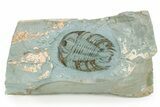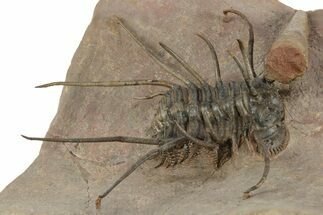2.7" Rare, Lower Cambrian Gigantopygus Trilobite - Issafen, Morocco
This is 2.7" long example of Gigantopygus papillatus (Hupe’ 1953) from the Issafen Formation of Morocco. This elegant trilobite is one of the rarer species found in this fauna. It is nicely presented on a solid slab of shale.
It comes with an acrylic display stand.
It comes with an acrylic display stand.
In the past few years, deposits near Issafen, Morocco have begun yielding a new assemblage of Early Cambrian trilobites. This fauna is very diverse and consists mainly of ellipsocephalids, chengkouiids, gigantopygids, holmiids, neltneriids, saukiandids, and the latest fallotaspids. The shale is a greenish to slightly yellow color when freshly split, but weathers to a light grey.
About Trilobites
Trilobites are an extinct class of marine arthropods that thrived for nearly 270 million years, from the early Cambrian to the end of the Permian period (around 521 to 252 million years ago). They are one of the most successful and diverse groups in the history of life, with over 25,000 described species spanning a wide range of sizes, shapes, and ecological niches. Known for their distinctive, segmented exoskeletons, trilobites provide invaluable insights into the evolutionary history of arthropods and the dynamics of ancient marine ecosystems.
Trilobites are an extinct class of marine arthropods that thrived for nearly 270 million years, from the early Cambrian to the end of the Permian period (around 521 to 252 million years ago). They are one of the most successful and diverse groups in the history of life, with over 25,000 described species spanning a wide range of sizes, shapes, and ecological niches. Known for their distinctive, segmented exoskeletons, trilobites provide invaluable insights into the evolutionary history of arthropods and the dynamics of ancient marine ecosystems.
$795
SPECIES
Gigantopygus papillatus
LOCATION
Issafen, Morocco
FORMATION
Issafen Formation
SIZE
2.7" long on 7.4 x 4.5' shale
CATEGORY
SUB CATEGORY
ITEM
#255445
We guarantee the authenticity of all of our specimens.
 Reviews
Reviews











